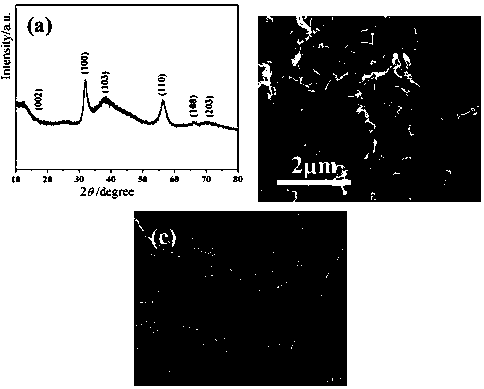A low-layer mose 2 Preparation method of nanosheet/nitrogen and phosphorus co-doped graphene composite nanomaterial
A graphene composite and nanomaterial technology, applied in the direction of nanotechnology, nanotechnology, nanotechnology for materials and surface science, etc., can solve the problem of low phosphorus doping in phosphorus-doped graphene without considering effective regulation , uneven doping and other issues, to achieve the effect of easy expansion of industrial applications, convenient expansion of industrial applications, and high electrocatalytic activity
- Summary
- Abstract
- Description
- Claims
- Application Information
AI Technical Summary
Problems solved by technology
Method used
Image
Examples
Embodiment 1
[0030] A few-layer MoSe 2 The nanosheet / nitrogen and phosphorus co-doped graphene composite nanomaterial comprises the following steps:
[0031] S1. Ultrasonic disperse 3.0 mmol of graphene oxide in 45 mL of deionized water, then add 1.5 mmol of tetrabutylphosphine bromide and stir thoroughly for 12 hours, then add 1.5 mmol of sodium molybdate and 15 mL of 3 mmol of selenium powder in sequence. Ammonia solution, and keep stirring to completely dissolve the sodium molybdate.
[0032] S2. Transfer the mixed solution obtained in S1 (total volume is 60mL) to a 100 mL hydrothermal reaction kettle, put the reaction kettle in a constant temperature oven, and let it cool down to room temperature after hydrothermal reaction at 240°C for 24 hours , the solid product was collected by centrifugation, washed thoroughly with deionized water, and dried in vacuum at 80°C; the solid product obtained above was heat-treated at 800°C for 2 hours in a nitrogen atmosphere to prepare MoSe with few ...
Embodiment 2
[0037] A few-layer MoSe 2 The nanosheet / nitrogen and phosphorus co-doped graphene composite nanomaterial comprises the following steps:
[0038] S1. Ultrasonic disperse 3.0 mmol graphene oxide in 45 mL deionized water, then add 4.5 mmol tetrabutylphosphine bromide and stir thoroughly for 12 hours, then add 1.5 mmol sodium molybdate and 15 mL dissolved 3 mmol selenium powder The hydrazine solution, and keep stirring to completely dissolve the sodium molybdate.
[0039] S2. Transfer the mixed solution obtained in S1 (total volume is 60 mL) to a 100 mL hydrothermal reaction kettle, put the reaction kettle in a constant temperature oven, and let it cool naturally to At room temperature, the solid product was collected by centrifugation, washed thoroughly with deionized water, and dried in vacuum at 80 °C; then the solid product obtained above was heat-treated at 800 °C for 2 hours in a nitrogen atmosphere to prepare MoSe with few layers 2 Nanosheet / Nitrogen and Phosphorus Co-dop...
Embodiment 3
[0044] A few-layer MoSe 2 The nanosheet / nitrogen and phosphorus co-doped graphene composite nanomaterial comprises the following steps:
[0045] S1. Ultrasonic disperse 3.5 mmol graphene oxide in 45 mL deionized water, then add 6 mmol tetrabutylphosphine bromide and stir thoroughly for 12 hours, then add 2 mmol sodium molybdate and 15 mL dissolved 4 mmol selenium powder in sequence The hydrazine solution, and keep stirring to completely dissolve the sodium molybdate.
[0046] S2. Transfer the mixed solution obtained in S1 (total volume is 60 mL) to a 100 mL hydrothermal reaction kettle, put the reaction kettle in a constant temperature oven, and let it cool naturally to At room temperature, the solid product was collected by centrifugation, washed thoroughly with deionized water, and dried in vacuum at 80 °C; the solid product obtained above was heat-treated at 700 °C for 2 hours in a nitrogen atmosphere to prepare MoSe with few layers 2 Nanosheet / Nitrogen and Phosphorus Co-...
PUM
 Login to View More
Login to View More Abstract
Description
Claims
Application Information
 Login to View More
Login to View More - R&D
- Intellectual Property
- Life Sciences
- Materials
- Tech Scout
- Unparalleled Data Quality
- Higher Quality Content
- 60% Fewer Hallucinations
Browse by: Latest US Patents, China's latest patents, Technical Efficacy Thesaurus, Application Domain, Technology Topic, Popular Technical Reports.
© 2025 PatSnap. All rights reserved.Legal|Privacy policy|Modern Slavery Act Transparency Statement|Sitemap|About US| Contact US: help@patsnap.com



